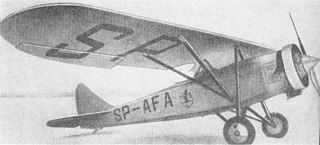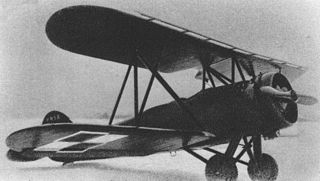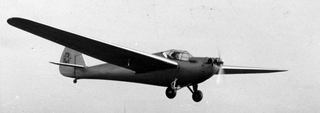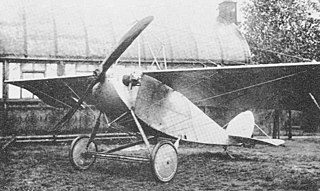| HFM-2 | |
|---|---|
 | |
| HFM-2a on display at the Finnish Airforce Museum | |
| Type | Flat-twin aero engine |
| National origin | Germany |
| Manufacturer | Haacke Motorenbau, Johannisthal (Berlin) |
The Haacke HFM-2 was a German two cylinder flat engine built in the early 1920s. [1]
| HFM-2 | |
|---|---|
 | |
| HFM-2a on display at the Finnish Airforce Museum | |
| Type | Flat-twin aero engine |
| National origin | Germany |
| Manufacturer | Haacke Motorenbau, Johannisthal (Berlin) |
The Haacke HFM-2 was a German two cylinder flat engine built in the early 1920s. [1]
From Flight [2]
Data from Flight [2]
Comparable engines
Related lists

The Nikol A-2 was a small, amphibious aircraft designed and built in Poland in the 1930s. Only one was completed before World War II.

The PZL P.6 was a Polish fighter, designed by the engineer Zygmunt Puławski, manufactured by PZL state-owned factory. It remained a prototype.

The Lublin R-X was a Polish single-engined, two seat liaison aircraft, built in 1929 in the Plage i Laśkiewicz factory in Lublin. Seven were completed, two of them prototypes. Four served with Polish air regiments and another made several notable long flights and tours.

The PZL Ł.2 was the Polish Army cooperation and liaison aircraft, built in 1929 in the Polskie Zakłady Lotnicze (PZL) in Warsaw. Only a small series of 31 aircraft, including prototype, were made, and used by the Polish Air Force in the 1930s. The aircraft was known in Poland for accomplishing of a long-distance tour around Africa in 1931.

The PWS-20 was a Polish single-engine high-wing passenger aircraft for 6 passengers, built in PWS factory in 1929, that remained a prototype. It was the first Polish passenger plane.

The Motyl was an early Polish glider constructed by the Poznań Aviation Circle of the Heavy machinery School under the supervision of Michal Bohattrew. The Motyl was entered in the Second Polish Glider Contest, at Oksywie near Gdynia on the Baltic coast, with contest number 20, piloted by Gorzke. The Motyl had a span of 10m, length of 6.7 m (22 ft), wing area of 17m2 (183 ft2) and an aspect ratio of 5.9 with a plywood covered rectangular section fuselage. Little is known of its achievements or detail of the structure.
The RWD 18 was a four/five seat STOL utility aircraft designed and built in Poland from 1936.

The PWS-5 or PWS-5t2, was a multi-seated Polish liaison aircraft, developed in 1928 by PWS.

The PWS-6, was a Polish liaison aircraft, developed in 1930 by the PWS, that remained a prototype.

The Bąk (Horse-Fly) was a single seat motor glider designed and built in Poland from 1936.

The P.Z.L. 27 was a prototype airliner/mail plane designed by Zbysław Ciołkosz and constructed at P.Z.L. in 1933.
RWD 22 was a Polish twin-engine torpedo bomber and naval reconnaissance floatplane design. Developed by Leszek Dulęba and Andrzej Anczutin of Doświadczalne Warsztaty Lotnicze in 1939, the project was to be developed under the brand of the RWD design bureau. The outbreak of World War II interrupted the design and it never left the planning stage.
The Dietrich-Gobiet DP.VII was a simple, low power, German sports aircraft flown in early 1924.

The Gabriel P 5 was the first nationally developed aircraft to fly in Poland after it became independent in 1918. It was an amateur-built, low-powered, single seat parasol wing machine. Only one was completed.

The Silesia S-3 was the first design from the Polish Sopora brothers to fly. It was a low power, single seat, high wing light aircraft. Only one was built and its flying time was limited.
The Silesia S-4 was a Polish, low-power parasol wing aircraft built in 1925. After an engine change and airframe modifications it became one of the Silesian Aeroclubs fleet. It was lost in a take-off accident in 1931 and was the last Silesia aircraft to fly.

The Działowski D.K.D.1 was the first powered aircraft designed by Stanislaw Działowski. It was a low-power high-wing monoplane with a cabin for one passenger. After attending an aviation exhibition in Warsaw in 1927 it was badly damaged when the engine failed as it left and it did not fly again.
The Gabriel Śląsk (Silesia) was a Polish light aircraft designed and built by an amateur in the mid-1930s. After two flights the Polish authorities banned further development.
The Ścibor-Rylski ŚR-3 was a Polish, ultralight, low power, single-seat sports aircraft. First flown in August 1939, only one was completed before World War II.

The Czerwiński CW 8 was a mid-1930s Polish open-frame basic training glider. Its design was advanced and its price low, but its stalling characteristics were too dangerous for beginners, so the thirty-plus examples completed were rapidly withdrawn from use. Two were subsequently modified, one with greater span and the other with a small engine.
| Wikimedia Commons has media related to Haacke HFM 2 . |